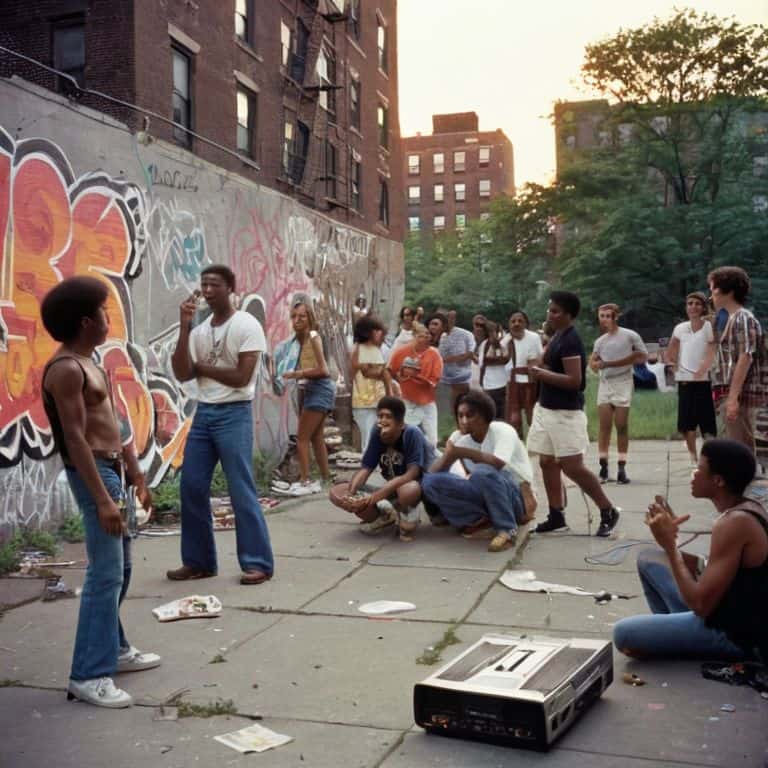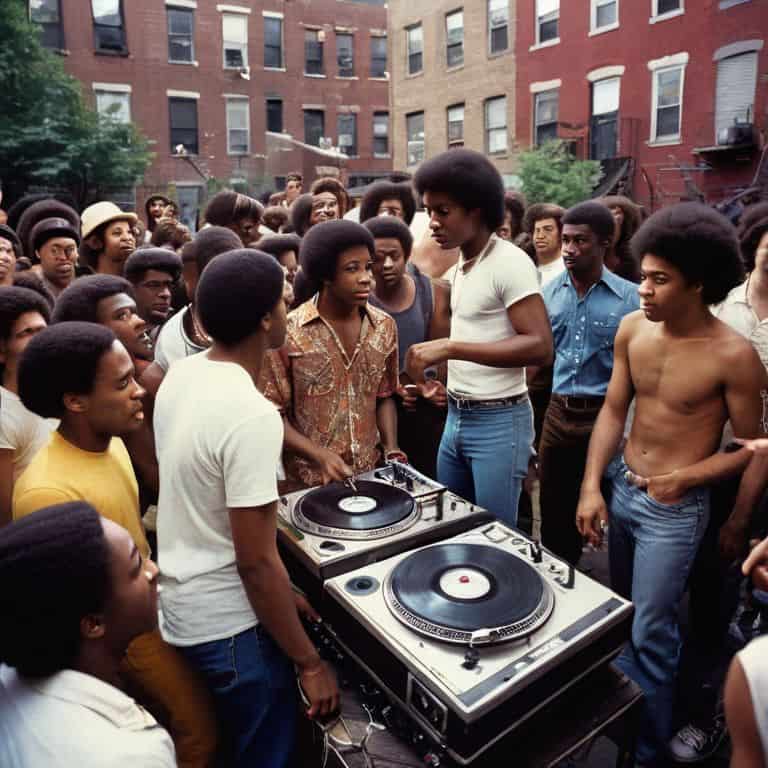I still remember the first time I stumbled upon a grainy VHS tape of an early hip hop performance in the Bronx – the raw energy, the unbridled creativity, and the unmistakable sense of rebellion that defined the birth of hip hop in the Bronx. It was as if I had uncovered a hidden chapter in the history of music, one that spoke to the frustrations and aspirations of a generation. The sounds of Grandmaster Flash, Afrika Bambaataa, and the Cold Crush Brothers were more than just a novelty – they were a testament to the power of art to challenge social norms and push the boundaries of what was possible.
As I delve into the story of the birth of hip hop in the Bronx, I promise to cut through the myths and misconceptions that have accumulated over the years. I’ll take you on a journey through the _streets of the South Bronx_, where hip hop was forged in the fires of creativity and resistance. My goal is to provide a _no-nonsense_ account of how this cultural phenomenon emerged, and what it reveals about the human spirit’s capacity for innovation and self-expression. By exploring the intersection of music, art, and social justice, we’ll uncover the essence of hip hop’s enduring appeal and its continued relevance in today’s world.
Table of Contents
Rhymes and Revolt

As I delve into the early hip hop culture, I’m struck by the infectious energy that pulsed through the streets of the Bronx. It was an era where funk and soul rhythms merged with the raw, unbridled spirit of youth, giving birth to a unique sound that would soon captivate the world. The influence of funk and soul on hip hop is undeniable, with legends like James Brown and Sly Stone laying the groundwork for the genre’s distinctive beats and lyrical flair.
In this tumultuous landscape, breakdancing history was being written, with crews like the Rock Steady and the Dynamic Rockers pushing the boundaries of physical expression. Their athletic feats, set to the pulsating backdrop of hip hop’s early anthems, not only reflected the era’s restlessness but also helped to galvanize a sense of community among the disenfranchised. As hip hop and social justice began to intersect, the genre’s potential as a powerful tool for storytelling and activism started to take shape.
The evolution of hip hop music was also deeply intertwined with the role of graffiti in hip hop, as vibrant murals and tags became an integral part of the genre’s visual identity. This symbiotic relationship between sound and image helped to amplify hip hop’s message, transforming cityscapes into dynamic canvases that reflected the hopes, fears, and aspirations of a generation. As I reflect on this pivotal moment, I’m reminded that the true power of hip hop lies not just in its rhythms, but in its ability to give voice to the voiceless.
Breakdancing History Unleashed
As I delve into the world of hip hop, I’m reminded of the electric atmosphere that surrounded the emergence of breakdancing. This dance form, born out of the streets, was more than just a series of intricate moves – it was a statement of rebellion, a way for young people to express themselves and tell their stories through movement.
The cultural significance of breakdancing cannot be overstated, as it played a pivotal role in shaping the visual identity of hip hop. With its dynamic spins and flips, breakdancing added a new dimension to the genre, one that would inspire countless fans and help spread hip hop’s influence far beyond the Bronx.
Funk and Souls Hidden Hand
As I delve into the sonic landscape of 1970s Bronx, I’m struck by the fertile ground that funk and soul music laid for hip hop’s emergence. The genre’s emphasis on rhythm, groove, and storytelling created a cultural tinderbox, waiting for the spark of hip hop to ignite.
The Sampling Revolution that followed was a direct result of this convergence, with DJs and producers weaving together fragments of funk and soul classics to create a new sonic tapestry.
Bronx Births Hip Hop

As I delve into the early hip hop culture, I’m struck by the profound impact of funk and soul on the genre’s development. The infectious beats and socially conscious lyrics of funk and soul artists paved the way for hip hop’s unique sound and message. In the Bronx, where hip hop was born, these influences merged with the raw energy of breakdancing and the vibrant world of graffiti, giving birth to a distinct cultural movement.
The influence of funk and soul on hip hop can be seen in the genre’s emphasis on rhythm and storytelling. Hip hop pioneers like DJ Kool Herc and Afrika Bambaataa drew inspiration from funk and soul legends, incorporating their sounds and styles into the nascent hip hop scene. This fusion of genres helped shape the evolution of hip hop music, as artists began to experiment with new sounds and themes.
In the midst of this creative explosion, breakdancing history was being written on the streets of the Bronx. As breakdancers spun and flipped to the rhythms of hip hop, they embodied the genre’s spirit of rebellion and self-expression. With graffiti artists leaving their mark on the city’s walls, hip hop culture was becoming an integral part of the urban landscape, forever changing the face of music and art.
Evolution of Hip Hops Sonic
As hip hop evolved, its sound underwent a significant transformation, incorporating elements from various genres to create a unique sonic landscape. This evolution was characterized by the experimentation of DJs and producers, who pushed the boundaries of what was possible with music production. The result was a diverse range of styles, from the laid-back flows of old-school hip hop to the more aggressive, in-your-face approach of gangsta rap.
The incorporation of live instruments and jazz samples added a new layer of depth to hip hop, allowing artists to express themselves in innovative ways. This fusion of styles helped to further establish hip hop as a major force in the music industry, paving the way for future generations of artists to experiment and innovate.
Graffitis Vibrant Social Justice
As I delve into the world of early hip hop, I’m reminded that graffiti was more than just an art form – it was a visual manifesto for social change. The vibrant murals that covered Bronx buildings weren’t just aesthetic expressions, but bold statements of resistance and identity.
In this context, graffiti as protest became a powerful tool for marginalized voices to be heard. By reclaiming public spaces with their art, graffiti artists were able to convey messages of hope, frustration, and solidarity, leaving an indelible mark on the city’s landscape.
Unpacking the Foundations: 5 Key Insights into the Birth of Hip Hop in the Bronx
- Understand the socio-economic context of the Bronx in the 1970s, where hip hop was born out of poverty, crime, and urban decay, yet thrived as a form of artistic rebellion and social commentary
- Recognize the pivotal role of DJs like Kool Herc and Afrika Bambaataa, who experimented with extending breakbeats and fostering a sense of community through their parties, laying the groundwork for hip hop’s evolution
- Appreciate the influence of funk and soul music on early hip hop, as genres like disco and rock also played a part in shaping the sound and style of the emerging hip hop culture
- Explore the intersection of hip hop with other forms of expression like breakdancing and graffiti, which not only reflected the art form’s versatility but also its ability to reclaim and redefine urban spaces
- Consider the legacy of hip hop as a platform for social justice and political expression, from its early days in the Bronx to its current global reach, and how it continues to reflect and shape societal attitudes towards race, class, and identity
Three Key Takeaways from the Birth of Hip Hop
Hip hop’s genesis in the Bronx was a cultural insurrection, sparked by the convergence of funk, soul, and social unrest, which forever altered the music landscape and reflected the era’s deepest anxieties and desires
The evolution of hip hop is inextricably linked to the rise of breakdancing and graffiti, which not only provided a visual and kinetic representation of the music but also served as a powerful medium for social justice and self-expression
By examining the sonic, social, and cultural shifts that occurred during hip hop’s formative years, we can gain a profound understanding of the genre’s enduring impact on contemporary culture and its continued ability to reflect, shape, and challenge societal norms
Unpacking the Genesis
The birth of hip hop in the Bronx was not just a musical phenomenon, but a socio-cultural insurrection – a bold, unapologetic declaration of identity, community, and creative resistance that would forever alter the sonic and social landscape of our world.
Julian Thorne
The Beat Goes On: Hip Hop's Enduring Legacy

As I reflect on the birth of hip hop in the Bronx, I’m struck by the cultural convergence that made it all possible – funk, soul, breakdancing, and graffiti art coming together in a swirl of creativity and rebellion. From the hidden hand of funk and soul to the vibrant social justice of graffiti, each element played a crucial role in shaping the genre. The evolution of hip hop’s sonic landscape, from its humble beginnings to its current global phenomenon, is a testament to the power of art to reflect and shape our deepest anxieties and desires.
And so, as we look to the future, let’s remember that hip hop’s true strength lies not just in its beats or rhymes, but in its ability to give voice to the voiceless and challenge the status quo. As we continue to navigate the complexities of our chaotic world, let’s draw inspiration from the Bronx’s unlikely revolutionaries, who proved that even in the darkest alleys and most forgotten corners, creative insurrection can ignite, inspiring a new generation to find their own rhythm and revolt.
Frequently Asked Questions
What role did social and economic conditions in the Bronx play in shaping the early days of hip hop?
The Bronx’s bleak socio-economic landscape – ravaged by poverty, crime, and urban decay – ironically fertilized hip hop’s growth. Desperation and disillusionment fueled the creative rebellion, as youths transformed abandoned spaces into vibrant hubs of self-expression, their rhymes and rhythms echoing the frustrations and hopes of a community struggling to survive.
How did hip hop's evolution in the Bronx reflect and influence the broader cultural and political landscape of the 1970s?
As I delve into hip hop’s Bronx roots, it’s clear that the genre’s evolution mirrored the era’s socio-political turmoil – a sonic reflection of urban decay, rebellion, and resilience, influencing the broader cultural landscape with its unapologetic voice and unbridled energy.
In what ways did the convergence of funk, soul, and other musical genres in the Bronx contribute to the unique sound and style of early hip hop?
The convergence of funk, soul, and other genres in the Bronx was hip hop’s sonic petri dish. DJs like Kool Herc and Afrika Bambaataa sampled and reworked funk and soul classics, merging breakbeats with socially conscious lyrics, giving birth to a distinctive sound that was both rebellious and infectious.
